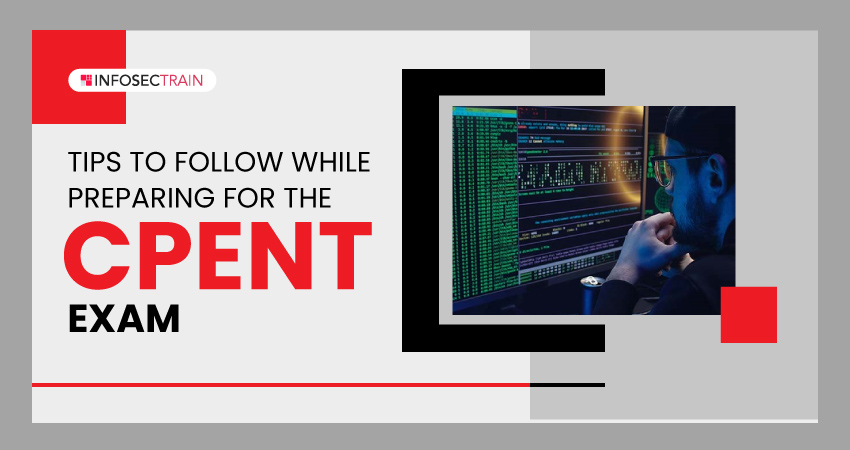Tips to Follow while Preparing for the CPENT Exam

What is the CPENT Exam?
EC-Council’s Certified Penetration Tester (CPENT) is an advanced-level cybersecurity credential for experienced security experts and ethical hackers who wish to enhance and assess their penetration testing abilities and skills. This certification aids in performing the thorough evaluations needed to efficiently detect and reduce security risks to computer systems, networks, and infrastructures. It will teach you how to conduct successful penetration testing in a network environment designed for businesses that must be targeted, exploited, avoided, and protected.
The certification will assist in understanding how to do penetration testing on modern businesses’ networks, including IoT and OT systems. You will learn how to perform advanced Windows attacks, bypass filtered networks, write your own exploits, single and double pivoting, conduct binary exploitation and advanced privilege escalation, customize scripts, and more.
The CPENT certification exam is fully practical, conducted online, and remotely proctored.
Exam Details
| Exam Name | Certified Penetration Testing Professional (CPENT) |
| Exam Duration | You can choose from:
|
| Passing Score | If you score between 70%-90%, you will get a CPENT certification,
If you score more than 90%, you will get a Licensed Penetration Tester (LPT) Master certification |
| Exam Format | Performance-based |
| Exam Languages | English |
Tips to Prepare for the CPENT Exam
The following tips will help you to prepare for the CPENT certification.
1. Prioritize Targets
CPENT helps you become a professional team member to manage the realm of penetration testing and prioritize penetration tests. So, you must understand how to set priorities for your targets and develop strategies for them. You should practice extracting data from your protected and filtered network using various methods and understand how to record and extract data efficiently for the report. It is a priority to have a comprehensive target database before launching an exploit. It would help if you also employed the EC-Council practice tests or its labs.
2. Implement a Systematic Approach
Implementing a systematic approach for identifying your host and services and determining which services are vulnerable is the most crucial step in preparation for the CPENT exam.
3. Knowledge of Active Directory (AD) Attack
Windows Active Directory (AD) deployments are utilized almost everywhere. But nowadays, APT groups actively use various methods to attack Active Directories (ADs). Therefore, you must be aware of AD attacks. You should be able to evaluate AD’s security posture from multiple perspectives and become knowledgeable about the several attack methods that can be used against it, including GPP passwords, password spraying, lateral movement, privilege escalation, and kerberoasting.
4. Knowledge of OT Devices
Many large organizations use Operational Technology (OT) devices along with IT, so you must be familiar with them. You should be able to detect and analyze the weaknesses of these devices accessing the OT network. You must be technically skilled and knowledgeable about OT networks for penetration testing. If you know about the capabilities and weaknesses of OT networks, conducting penetration testing will be simple and cause no harm to the network’s security and functionality.
5. Take Notes of Sessions
To perform effectively, you should take notes during the learning session; it will be helpful during penetration testing. These notes will help you identify which network addresses are under the scope of the work, and also, with this information, you can build a target database template.
6. Take Less Time in Scanning
To prepare for the CPENT exam, comprehend and use the best tools or vulnerability scanners. Update and upgrade the existing tools you may be using. If you use the default scan and intense scan for all ports, the scan could take a long time. There are various penetration testing tools that will make it simple to detect vulnerabilities while saving you time. You can use valuable tools, including NMAP, Metasploit, Nessus, Intruder, Nikto, and Burp Suite.
7. Practice a Lot
Since the CPENT is a practical exam, you should take a practice exam in the EC-Council iLabs before scheduling the exam. It is the best resource for anyone wishing to learn more about hacking or improve their penetration testing skills. If you feel confident taking the exam, you can try the cyber practice range, which simulates a real-world cyberattack that will help you see your preparation level.
8. Do Not Make Any Assumptions
In a penetration testing scenario, assumptions can lead to inaccurate conclusions, missed vulnerabilities, and ineffective testing strategies. To align with the skill and thoroughness expected in penetration testing, it is crucial to conduct comprehensive research and verification to identify vulnerabilities and weaknesses accurately. This approach forms the core of the CPENT exam’s requirements.
Checkout the related blogs:
- How to prepare for C|PENT Exam?
- Top Penetration Testing Trends to Follow
- Difference Between Internal and External Penetration Testing
- Top Methodologies to Improve Penetration Testing
CPENT with InfosecTrain
Elevate your expertise in the cybersecurity domain with the highly sought-after CPENT credential. Mastering the CPENT certification exam preparation does not have to be complex. With the right tools and approach, you can position yourself as an elite Penetration Tester. Unleash your potential through InfosecTrain‘s comprehensive CPENT certification training. As the global leader in cybersecurity and IT security training, we will empower you to excel on the exam and beyond. Seize this opportunity to refine your skills and join the ranks of top-tier Penetration Testers worldwide. Enroll today and embark on a journey to unlock limitless possibilities.




 1800-843-7890 (India)
1800-843-7890 (India) 
